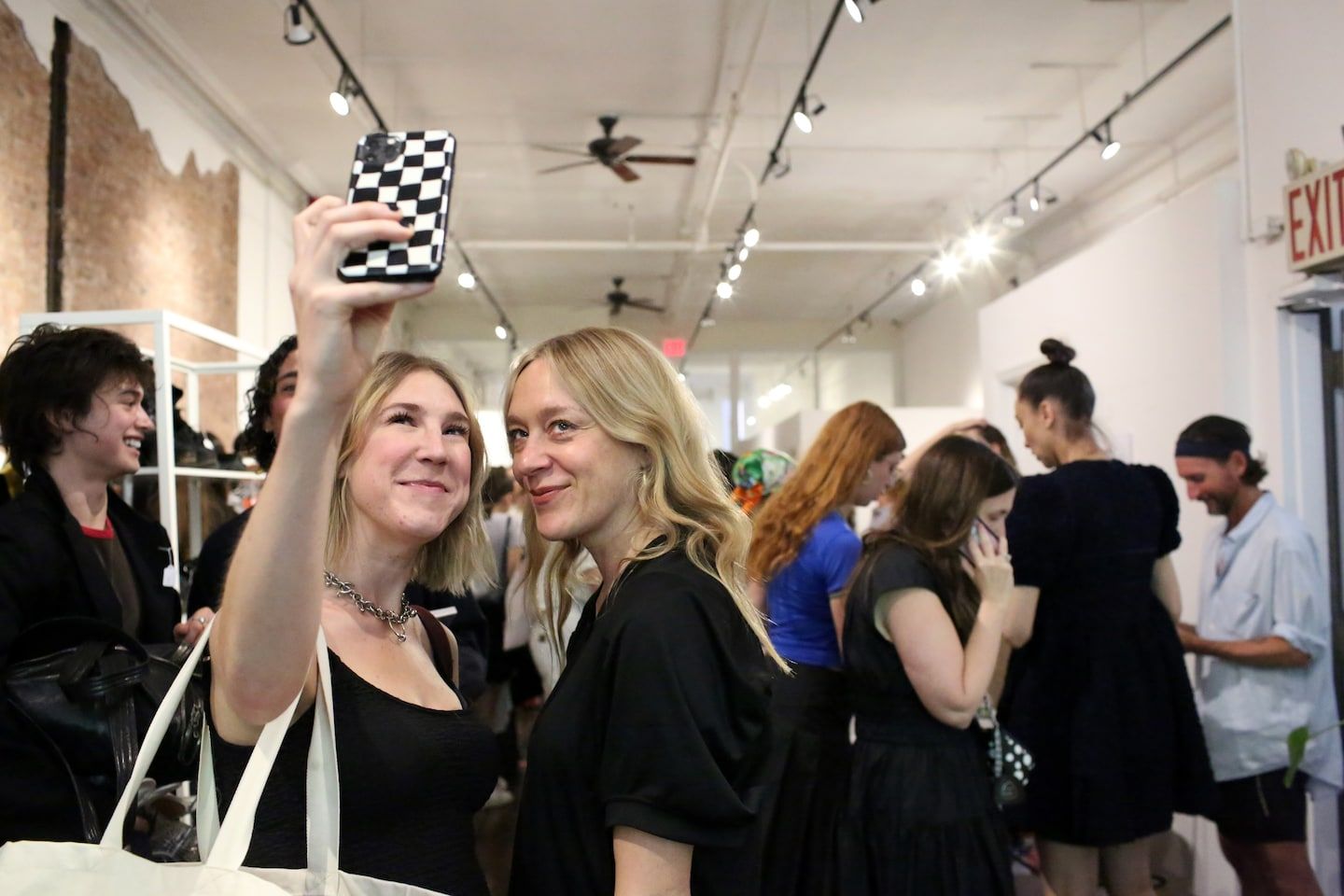Chloe Sevigny’s ‘Sale of the Century’ causes a frenzy
Listen 10 min Comment on this story Comment Gift Article Share
NEW YORK — On Sunday morning on Broadway, just above SoHo, three very patient women were at the front of the city’s chicest line: the queue to enter a monumental sale of castoffs from the closets of Chloë Sevigny, Lynn Yaeger, Sally Singer and Mickey Boardman, and past seasons’ pieces from the menswear-inspired brand the Academy.
Arriving at 6 a.m., the women had been waiting at that point for more than five hours for the “Sale of the Century,” an event organized by writer Liana Satenstein and her team of vintage-fashion enthusiasts.
For those three, it was the magic of Sevigny that made the hours-long wait worth it. The Oscar-nominated actress has long been beloved for the sheer originality of her style and the breadth of her vintage wardrobe. A tour she gave to the defunct retailer Opening Ceremony of her closet more than a decade ago frequently pops up on TikTok, where vintage clothing (or, more accurately, secondhand designer clothing) is an obsession. “It feels really special to be able to shop her pieces,” said Raya DerBedrossian, 23.
“She’s been the ‘it girl’ of New York since the it girl of New York even started,” said Waverly Bruno, 27, speculating that there might be a number of pieces inside “that were in iconic moments of history.” (Sevigny herself has expressed ambivalence about the it girl label, often mentioning in interviews forebears such as Edie Sedgwick and Clara Bow.)
Advertisement
In the days leading up to the sale, Sevigny stoked the excitement by posting pictures of herself in items destined for the racks, such as a Versace jumper — which pop star Olivia Rodrigo had her stylist procure through a friend, with the matching jacket, early in the sale — and a Versace Medusa-print minidress.
Inside, on a second-floor loft space with creaky floors and flooded with light, was indeed a fashion freak’s paradise. Satenstein, a former Vogue writer, is well known in the vintage-fashion community for her ability to predict revivals of designers on the vintage market and her therapeutic approach to closet cleaning, including an Instagram Live series called “#neverworns,” in which she discusses what pieces a guest should keep, donate or sell.
She had worked with her team to organize and merchandise the space with meticulous delight, offering racks of clothes that acted like little biographies of each of the sellers. “All the people involved are really fashion-fashion-fashion people,” as Boardman, who was an editor at Paper for three decades, put it, “who have well-known looks and well-developed style.”
Advertisement
Bulbous Comme des Garçons dresses and coats burst from Yaeger’s racks. (“Her closet is my Vivienne Westwood fantasy,” Singer said.) Countless lace and tulle dresses, many with shredded hems and priced around $50, hung in Sevigny’s section, as did an $825 leopard-print coat by Supreme and a $150 tube top by Jean Paul Gaultier, a mix of the delicate and hard, the street and the fantastical.
In Singer’s corner, $150 vintage dresses with spiffy prints or illustrations sat next to a stunning white brocade minidress with coral and turquoise beading by Balenciaga under Nicolas Ghesquière. (The piece was priced at $1,000 but would have sold new for far more.) It was tantalizing to imagine the evenings she might have had in those clothes, getting ready in her onetime apartment in the Chelsea Hotel and charging out into the night. Boardman’s space was filled with the costume jewelry he’s known for layering over Ralph Lauren polos, as well as a Charles and Diana tea towel from his beloved collection of royals memorabilia.
Satenstein and her sellers were thoughtful about presenting a wide range of items. “Resale platforms, especially third-party ones, can only do so much and can only sell certain pieces,” Satenstein said. TheRealReal, for example, has a list of designer brands it accepts, and it can often be difficult to see the appeal of a filmy antique blouse on Depop, eBay or Etsy. “This felt like a great segue into giving context and pizazz to someone’s items that may not have been appreciated somewhere else,” Satenstein said. Sevigny lamented in an interview last week that thrift stores seem increasingly “overwhelmed with disposable brand stuff.” She wanted shoppers to be able to find, at a reasonable price, the kind of funky and beautiful things she grew up hunting for.
Advertisement
Satenstein is known for a style of closet clean-out that is more like therapy, and part of the sale’s appeal was that even the sellers’ trash was treasure. Once, while Satenstein was cleaning out one of Singer’s bags, she found an old Styrofoam plate. As it turns out, it was autographed by Bob Dylan, a souvenir from Singer’s early days waitressing in the city.
Sevigny is deeply attached to her immense clothing collection but found herself in a cycle of buying, selling and storing. Satenstein came to her storage unit with her assistant, Eden Pritikin, “and they were cutthroat,” Sevigny said.
“I feel like I’m also at a transition point,” she continued. “I’m 48. I just had a baby. I’m okay to transition out of certain things that maybe I would have been into before. Maybe that was a big impetus. There were a lot of things that weren’t maybe as pristine as now I want to present myself as. Maybe I don’t feel the need to draw so much attention [to myself]. Here I am buying a pink faux-fur Prada jacket for myself for Mother’s Day!” she laughed. “But maybe wanting to ease myself into something a little more subtle, or a little more grown-up.”
Advertisement
At noon, the doors opened, and the buyers’ faces had a look of wonder. Sevigny perched on a sofa by the entrance, signing copies of her 2015 Rizzoli book, and took selfies and chatted with fans. Shoppers quickly loaded their arms with piles of sheer white dresses, Depeche Mode T-shirts and vintage dresses in geometric 1970s prints. The three women who had been first in line scored a shaggy navy blue coat by Proenza Schouler for $200 and a khaki Mugler dress for $325, plus armfuls of other goodies.
By 1:05, Yaeger had made nearly $4,000. (Each seller is donating a portion of their profits to a charity of their choice.) Less than an hour later, her rack of skirts by Comme, Replika and Marc Le Bihan was empty, leaving just a few blouses by Chloé and animal-print cardigans. “This is the most money I’ve ever spent, like, impulsively,” said one woman, clutching two pairs of Tabi shoes by Maison Margiela and a miniskirt, to a friend. Pizza was delivered, and Satenstein took a box down to distribute pieces to those still bravely waiting in line. One man finally bought a much-discussed enormous black lacquered chess set by Chanel for $450. He said he “absolutely” planned to use it.
Among the starry-eyed zoomers were a few genuinely famous faces, including actress Tommy Dorfman, who gave Sevigny a big hug, and the security consultant and whistleblower Chelsea Manning. Dressed in Carmina shoes, skinny jeans and a fitted pink button-up, Manning said Singer and Sevigny had texted her to stop by. She was inspecting a pair of black combat boots by Solovair, a British company that, she explained, produced Doc Martens until the brand moved its manufacturing elsewhere.
The sense that shoppers were among fashion icons — fulfilling a fantasy of running amok in their closets — permeated. One shopper bought a white vest and matching trousers because Sevigny mentioned offhand that she’d worn it to dinner with Nicolas. (That would be Ghesquière, the designer who reinvented Balenciaga at the turn of the 21st century and who now helms Louis Vuitton’s womenswear.) Singer, a longtime Vogue editor, worked the cash register, advising buyers on the details of their purchases. “You know this Chloé from the era of Phoebe Philo?” she asked one shopper, referring to the period during which cult-favorite designer Philo was designing the French brand Chloé in the early 2000s with a flirtatious, party-girl grit.
Advertisement
To vintage buffs and those who treat their closets as burgeoning wearable museums, this kind of provenance is seductive.
It wasn’t that shoppers seemed to see this as a sort of celebrity auction, where Marilyn Monroe’s pill bottles are sold alongside discarded notes from acting school. It was that, to devotees, Sevigny, Yaeger, Boardman and Singer are known to few but genuine celebrities and those who know them, the kinds of personae who make fashion into something not only human, but also eccentric, exciting.
“I think it’s some illusion, some dream of what it’s like to be in fashion,” longtime fashion writer Yaeger said, her lips in their deep pink cupid’s bow. “I always think of myself as an outsider in this industry, even though I’ve been around for a million years, so maybe not.”
Niko Haagenson, 19, was more emphatic after chatting with Yaeger. “I think she’s a great example of true, true inclusivity,” he said, “where it doesn’t matter what your style is, how rich you are, who your parents are, whatever. She is just somebody who is so her.”
Gabriel Held, a vintage collector whose archive celebrities often borrow from, got the Versace printed minidress and several other items, including a faux-fur Marc Jacobs coat priced at $200. Considering that Sevigny and the other hosts held several such sales before, including some with Held, why did he think this one caused such a frenzy? Nostalgia. “Every generation since [her own] has been inspired by her,” he said. “Everybody’s here with the same hope to get a piece of history.”
That, and the general mania for secondhand designer clothes — nostalgia for clothes from periods when the shoppers were barely cognizant — especially among 20- and 30-somethings. Laura Reilly, 32, who edits a shopping newsletter called Magasin that focuses on designers and sales off the beaten path, said the huge interest in vintage clothes means it’s harder to find good stuff at a good price. “This is the ultimate edit,” she said.
It was a genuinely heartwarming scene. “If this doesn’t fit me, you should get it!” I heard friends say to one another more than once. A grinning mother and daughter, Donna and Bayleigh Young, shopped together — it was Mother’s Day, after all — walked out with more than 10 pieces, including “this Loewe thing,” Bayleigh said, which was a kind of vest that looked like football shoulder pads that she had been lusting after for “a long time.” Her mother scored Sevigny’s book (with an autograph, of course) and a pink cardigan from Sevigny’s clothing line for Opening Ceremony.
Advertisement
As the hours stretched on and shoppers continued to inspect torn band T-shirts and label-less faded vintage dresses with the same tenderness as that brocade Balenciaga dress, or Sevigny’s shearling Hermès coat, it seemed as if we were in a temporary utopia, where the value of a garment isn’t merely the label, but the story behind it, and the feeling that you, too, might have some fantastic adventure by just slipping your arms into the sleeves.
GiftOutline Gift Article
Source: The Washington Post


